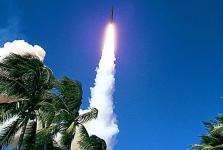 You’d think that after the dismal failures of previous tests, the Missile Defense Agency (MDA) would wait to run another public test until it was more confident that it could be more successful. Perhaps in tacit acknowledgment that day would never come, on July 5 the MDA launched an missile from the Marshall Islands to act as a fox to the hound of an interceptor launched from Vandenberg Air Force Base in California. But, this model interceptor, part of a system ostensibly justified by the existence of North Korea’s nuclear-weapons program, failed its third consecutive test.
You’d think that after the dismal failures of previous tests, the Missile Defense Agency (MDA) would wait to run another public test until it was more confident that it could be more successful. Perhaps in tacit acknowledgment that day would never come, on July 5 the MDA launched an missile from the Marshall Islands to act as a fox to the hound of an interceptor launched from Vandenberg Air Force Base in California. But, this model interceptor, part of a system ostensibly justified by the existence of North Korea’s nuclear-weapons program, failed its third consecutive test.
Afterwards the MDA issued this press release (emphasis added):
Although a primary objective was the intercept of a long-range ballistic missile target launched from … the Marshall Islands, an intercept was not achieved. …Program officials will conduct an extensive review to determine the cause or causes of any anomalies which may have prevented a successful intercept.
At Reuters, Andrea Shalal-Esa reports on one “anomaly.”
A failed U.S. missile defense test last week may be linked to a faulty battery that prevented an interceptor from separating from the rest of the rocket. … Riki Ellison, chairman and founder of the Missile Defense Advocacy Alliance, said preliminary findings into the missed intercept pointed to a failure of the final stage of the ground-based interceptor to separate, rather than a failure of the interceptor to detect, track or hit the target.
I’m not sure how Ellison determined that the interceptor didn’t fail to hit the target, when the final stage failed to launch and was thus unable to pursue the target, much less take it out. Would that were the least of its problems. In a blog post at Reuters, Dr. Yousaf Butt, now an adjunct senior fellow at the Federation of American Scientists, writes (emphasis added):
… the main problem is that the type of missile defense the United States and NATO are fielding — “midcourse” missile defense — is particularly easy to defeat using simple decoys and countermeasures. The simplest countermeasures are cheap inflatable balloon decoys.
If that’s news to you, take a moment to think about it. It’s as if, to reference our hunting metaphor again, hounds chasing a fox were diverted by PETA demonstrators waving stuffed animals in their faces. Also, missile defense has been compared to trying to hit a bullet with a bullet. As you can see, missile defense’s vulnerabilities are hardly just “anomalies.” They are, in fact, conceptual. Dr. Butt again.
Missile defense, the [the Pentagon’s own] scientists point out, is “predicated on the ability to discriminate” real warheads from other targets, “such as rocket bodies, miscellaneous hardware and intentional countermeasures.”
Those scientists also maintain that, if
… “the defense should find itself in a situation where it is shooting at missile junk or decoys, the impact on the regional interceptor inventory would be dramatic and devastating!”
Or as Ms. Shalal-Esa reports (emphasis added):
Until other tests validated the ability of the system to actually hit a target, U.S. military officials would also likely have to adjust their response and fire off additional interceptors in the event of any threat, he said.
Let’s take a moment to review why missile defense it considered destabilizing to nuclear deterrence. If nuclear power “A” thinks its weapons will be intercepted by “B’s” missile defense, it’s motivated to build more nuclear weapons and delivery systems to compensate for those that might be shot down. “A” also feels the need to increase its stockpile in anticipation of nukes destroyed on its own soil because “B’s” nuclear stockpile, protected by missile defense, wouldn’t be significantly harmed by “A’s” attack. “A” needs to compensate for when “B” responds and destroys a number of “A’s” nukes on “A’s” soil. Also, “A” is motivated to strike first to keep “B” from launching a first strike that would destroy many of “A’s” weapons on the ground.
Alluding to that, Dr. Butt writes that “the central conundrum of midcourse missile defense remains that while it creates incentives for adversaries and competitors of the United States to increase their missile stockpiles, it offers no credible combat capability to protect the U.S. from this weaponry.” By what I’ve emphasized, he means that missile defense is unproven.
In other words, missile defense not only provides incentives for other nuclear powers to increase their arsenals, but, because it’s hit or miss and requires many more weapons to be launched than an efficient system should, it needlessly depletes our own arsenal.
One embarrassing test failure after another won’t stop the administration, the Department of Defense, and MDA from falling headlong into the money pit, though. As Ms. Shalal-Esa reports, at the cost of $1 billion
The Pentagon has said the test will not affect its decision to add 14 new interceptors.
